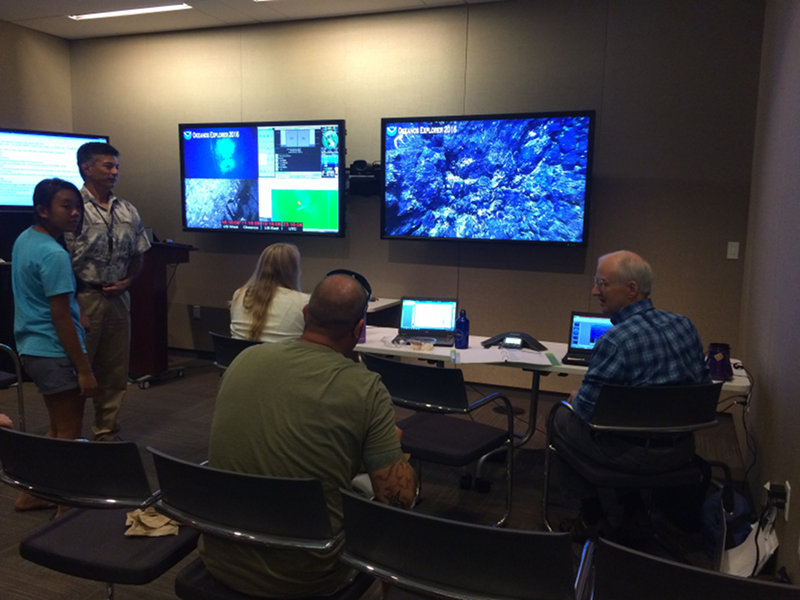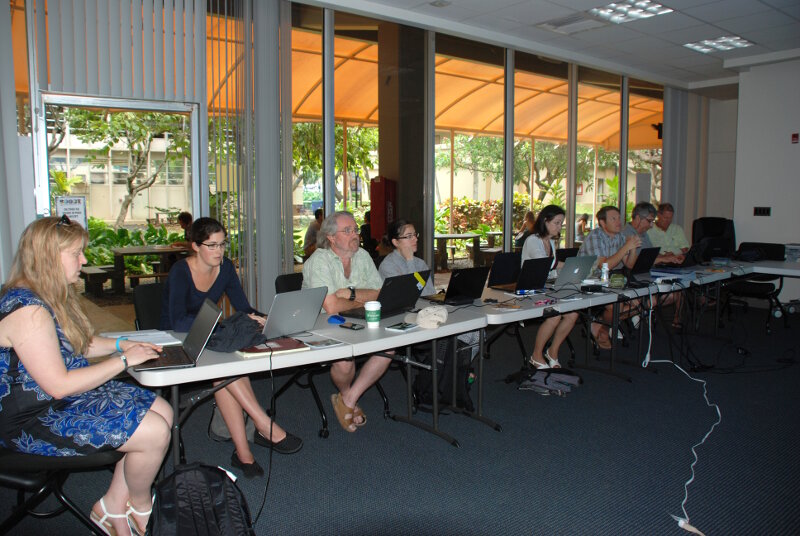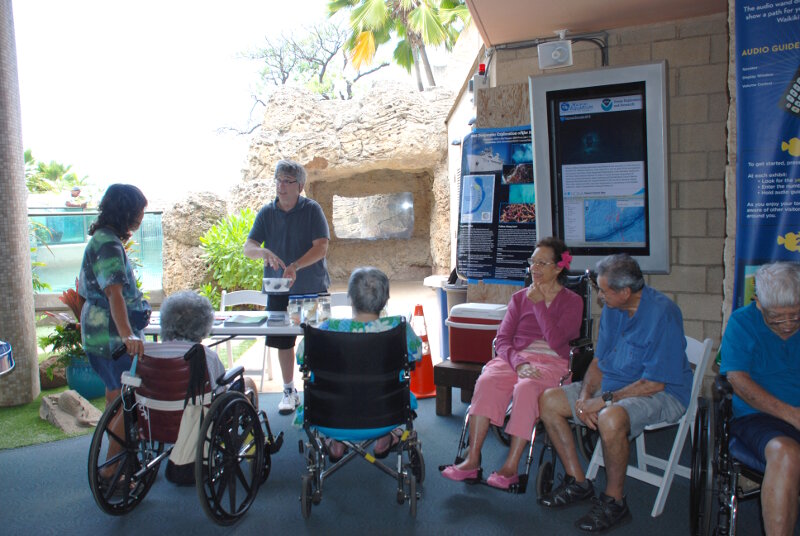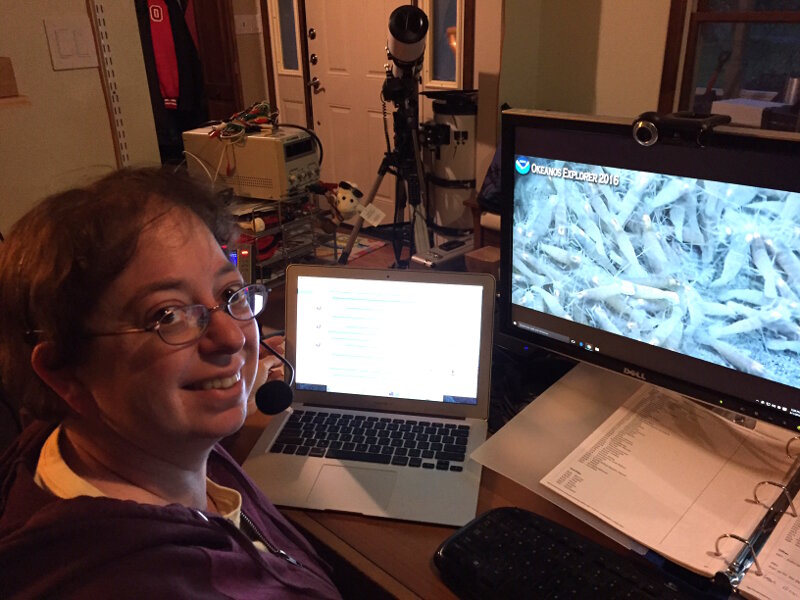
By Amanda Netburn - NOAA Office of Ocean Exploration and Research
Bob Stern - University of Texas at Dallas
May 5, 2016

Bruce Mundy (far right), Fish Biologist at NOAA Pacific Island Fisheries Science Center, discussing fish with a group of NOAA scientists and visitors with the live-video feed in the background at the NOAA Inouye Regional Center. Image courtesy of NOAA Office of Ocean Exploration and Research, 2016 Deepwater Exploration of the Marianas. Download larger version (jpg, 2.9 MB).
You get home from work or school, grab a snack, sit down and open up your computer, and in a couple of clicks you are transported to the seafloor, where you spend the next eight or so hours exploring the many different environments of the deep sea -- one day a seamount, another a hydrothermal vent, and another a mud volcano.

Scientists at the University of Hawaii at Manoa ECC watching a jellyfish swim by the ROV. Image courtesy of NOAA Office of Ocean Exploration and Research, 2016 Deepwater Exploration of the Marianas. Download larger version (jpg, 4.6 MB).
You look closely into a coral colony and see the details of every polyp, noticing it has been colonized by brittle stars. A shark swims by. Pillow lavas abound some days, and sometimes you watch hydrothermal “smoke” billowing out of a phantasmagorical chimney. There’s a fish hiding under a ledge. You encounter a seemingly endless field of basket stars. You never knew that there are fish that can give birth to live young.

The ECC at University of Hawaii at Manoa had a packed house for the Sirena Canyon dive. Image courtesy of NOAA Office of Ocean Exploration and Research, 2016 Deepwater Exploration of the Marianas. Download larger version (jpg, 5.7 MB).
No, you haven’t discovered teleportation, but if you’ve been following the live feed of the Okeanos Explorer, you have discovered the next greatest thing... Telepresence.

The science lead for this expedition, Chris Kelley, displays coral and crinoid specimens at the Waikiki Aquarium with the live stream in the background. Image courtesy of NOAA Office of Ocean Exploration and Research, 2016 Deepwater Exploration of the Marianas. Download larger version (jpg, 5.6 MB).
All NOAA Office of Ocean Exploration and Research expeditions on the Okeanos Explorer are live-streamed through telepresence technology. The general public can access an HD stream that has only ~30 seconds lag. For our shore-based scientists using Internet 2 at one of our Exploration Command Centers (ECCs) or a low-latency Internet 1 feed, the lag is only a few seconds. This allows us to get content to our shore-based scientists in near-real time, so that scientists from all over the country and the world can communicate directly with the ship-based team to direct operations.
This means that any scientist with an appropriate expertise located anywhere can help the team onboard decide what the remotely operated vehcle (ROV) should do next, what rocks and animals should be considered for collection, and what imagery we need to maximize our observations.

Tara Harmer Luke, Associate Professor of Biology at Stockton University, watching a swarm of hydrothermal vent shrimps on her home computer. Image courtesy of NOAA Office of Ocean Exploration and Research, 2016 Deepwater Exploration of the Marianas. Download larger version (jpg, 1.1 MB).
The public, students, and “armchair scientists” can not only watch along for every moment of all of our ROV dives, but they can also hear everything that both ship- and shore-based scientists are saying, providing not only unparalleled access to scientific knowledge from some of the greatest experts in the field, but also a unique opportunity to listen and learn from scientists’ discourse: what gets us excited, how we make real-time decisions, and our friendly debates on species identifications and hypotheses of mechanisms for different rock formations.
Another group of people who benefit from telepresence is the disabled. It is very difficult for disabled people to go to sea, or for disabled youngsters to consider a career in marine science. Even on a calm day, a ship constantly rolls and yaws. On a stormy day, it is hard to eat or think. Trust me, you do not want to experience a typhoon at sea! For these reasons, disabled students have been blocked from considering marine science as a career, and as active scientists age and are less able to go to sea, their expertise is lost.
Telepresence opens this world again to the disabled of all ages, and it is a wonderful gift to this community. This includes Robert Stern, Geosciences Professor at the University of Texas at Dallas and co-author of this essay, who can now do deep-sea research from the comfort of his own home. Bob is a geoscientist who is expert on the Marianas who was forced by his disability to stop going to sea in 2011. His participation has been essential to this expedition.
This expedition has been a great example of using the power of telepresence to bring together scientists. Our partners in Guam have been able to participate directly through telepresence. On our dive to the trench wall near the Sirena Deep east of Guam, we had ~12 scientists and students watching from the University of Hawaii at Manoa ECC. During an open house at NOAA’s Inouye Regional Center on Ford Island, Hawaii, we had many visitors drop by, including U.S. Navy sailors and even NOAA scientists who had not previously observed a ROV dive. As we discovered spectacular new hydrothermal vents on Dive 11, we had scientists calling in from all over the world, including a group that were watching from another research vessel -- the brand new R/V Neil Armstrong, based out of Woods Hole Oceanographic Institute.
It is great to see so many people participating, and we hope you all continue to follow along! Our next ROV leg is from June 17 – July 10.